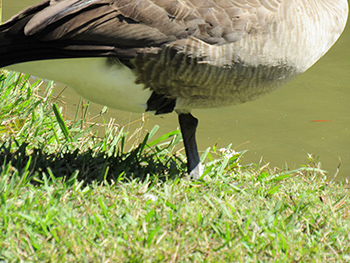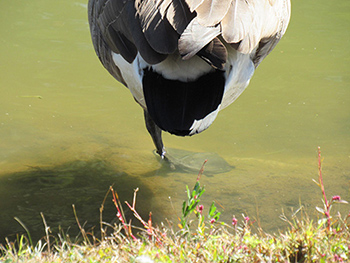Why Do Birds Stand on One Leg?
Why Do Birds Stand on One Leg?
By Bill Willis and Angela Dickerson
December 14, 2017

Photo courtesy of Bill Willis
Have you seen geese on campus standing by the water on one leg? You would think there must be a good reason for standing on one leg, because it requires balance and could put a lot of stress on a single appendage. Then again why do certain humans sit on their feet? What is known about this fowl activity?
Possible Explanations for Standing on One Leg?
We reported earlier in the Kids Page that the legs of water fowl are used to regulate and maintain body temperature during extremes of winter and summer. But, why just one leg at a time? Is there a survival value to having one leg up on the competition? Ideas abound as to why and researchers have eliminated certain ideas like easier/faster flight escape, mating pose, lessening fatigue, and helps them balance in the wind Possible explanations include:
- For a bird that spends most of its life standing in water, having one leg up would cut down on heat dissipation from the legs. The bird alternates between the left and right leg, so that neither leg gets too cold.
- Thermal regulation appears to be a plausible reason, and having one leg raised effectively locks the stilt leg in place so the bird can sleep suspended on one leg even in water. Gravity would help keep the leg locked in place.
Do Birds Exhibit Side Dominance/Preference like Humans?

Photo courtesy of Bill Willis
Geese are not the only birds to strand on one leg. Probably the best known is the pink flamingo common to zoos, salt lakes and suburban lawns. While flamingos have a right-side head tuck preference and favor the left leg support lock, there doesn’t seem to be a preference in the Canada geese.
Observing the NIEHS geese indicated that the support leg could be either depending on the flock and that there was not a pattern. The usual position is standing on two feet or sitting on two feet plus or minus eating. Statistics are difficult to obtain since geese don’t have synchronized flock movements. Getting them to stand in static formation was extremely difficult. Therefore, less than 10% were on one leg during any observation period (pose held for at least one minute to be counted).
Research assistance was provided by the NIEHS Library.



